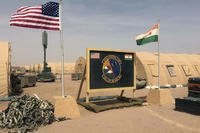NASHVILLE, Tenn. -- It's rare to hear Army acquisition's top leadership talk about the helicopter fleet, even though aviation eats up about 22 percent of the service's research, development and acquisition dollars, with a 2012 budget of $7.76 billion.
Most of the time, acquisition officials talk about delivering other modernization priorities, including the network, the Ground Combat Vehicle and a Humvee replacement. Lt. Gen. Bill Phillips, military deputy to the Army's acquisition executive, said Wednesday at the Army Aviation Association of America's annual forum there's a reason for that.
"The Army aviation portfolio is healthy. If I were to talk to you about other portfolios that exist like tactical wheeled vehicles, combat vehicles or missile defense -- it would look a little bit different," he said.
To be sure, Phillips, a career pilot, said the service must maintain its investments in its aviation fleet. Army helicopters have flown 3.6 million hours in Iraq and another 1.5 million hours in Afghanistan. To keep those helicopters in the air, the service must set aside money for the reset and potential recapitalization of those aircraft, he said.
Aviation leaders are already looking into whether the service needs to conduct a major overhaul on a fleet that has flown five to six times more over the past ten years than they ever expected.
"PEO Aviation is going through a series of studies by aircraft type as to what has been the impact of ten years of war and the aircraft flying in the very austere environment, and the challenges of being in that environment,” Phillips said. "So when we bring the aircraft back, do we need to do a bit more than reset? Do we need to do a recap? We have to get that right."
The Army must get it right because it doesn't plan to field the replacements for much of its fleet until 2030, with the Future Vertical Lift program. The Army has set out a plan to build an aircraft that will revolutionize almost everything, replacing helicopters at every level from the AH-6 Little Bird light attack helicopters to the CH-47 Chinook cargo helicopters. Engineers want to build a vertical lift aircraft that flies higher and faster than any comparable helicopter.
Army aviation officials have set Future Vertical Lift as their aim point 18 years out, even though the military is struggling to keep new weapons programs afloat. Phillips said that even though it may become painful, the Army must remain committed to the next generation vertical lift aircraft.
“I think the Army has to do this. I don’t think it can afford not to do it. We must invest in the future of rotorcraft,” he said.
Nonetheless, aviation officials have grumbled about the science and technology investment dollars the Army has so far siphoned off for them.
Maj. Gen. Tim Crosby, the Program Executive Officer, U.S. Army Aviation, called the $113 million set aside in 2012 for aviation S&T "budget dust." If the Army wants to build the Future Vertical Lift, it must drastically increase the funding, he said.
Phillips said he recognized Crosby's concerns and said he expects the service to spend more in future years.
"As we look at the budget … we have to make sure there is a level of sustainment for S&T funding to push technology, to look at the Future Vertical Lift capabilities with all the right communities to make sure we are doing all of the appropriate studies, we are looking at risk reduction, and having an aircraft that supports [Aviation Branch Chief Maj. Gen. Anthony] Crutchfield’s vision of 2030," Phillips said.
And Army aviation will not be devoid of modernization between now and 2030. For example, Phillips said he is focused on delivering stronger, more fuel efficient engines to the Army's Black Hawk and Apache fleets.
The Improved Turbine Engine Program promises to build an engine that is 25 percent more fuel efficient with a 65 percent increase in power-to-weight ratio than the T700-GE-701C/D engines that power the Apache and Black Hawk.
"I have supported ITEP for many years. I think it’s critically important," he said.
Another program Phillips wants to see delivered is the Armed Aerial Scout, but not at any cost. In the same way the service did with the Joint Light Tactical Vehicle program, Phillips said the Army must sit down and have a long talk and see what type of helicopter industry can deliver soon, and at what price.
Many Pentagon-watchers marked JLTV for the acquisition graveyard as costs spiraled above $500,000 per truck. To save the program, Army leaders traded a long list of requirements to cut the cost in half and subtract 15 months from the development phase. (Of course, the Army and Marine Corps still must try to preserve as much of that savings as possible when they actually contract and build the vehicles.)
For its new armed scout, Army plans to hold a flight test this June to test the helicopters that competitors could submit. Crosby has said he wants to see these aircraft in the air, not on Power Point slides.
"Feedback from industry is so critical for the Armed Aerial Scout going forward," Phillips said. "It’s industry who builds these systems and they know if it meets certain requirements. If we listen to industry they can tell us about the art of the possible."








